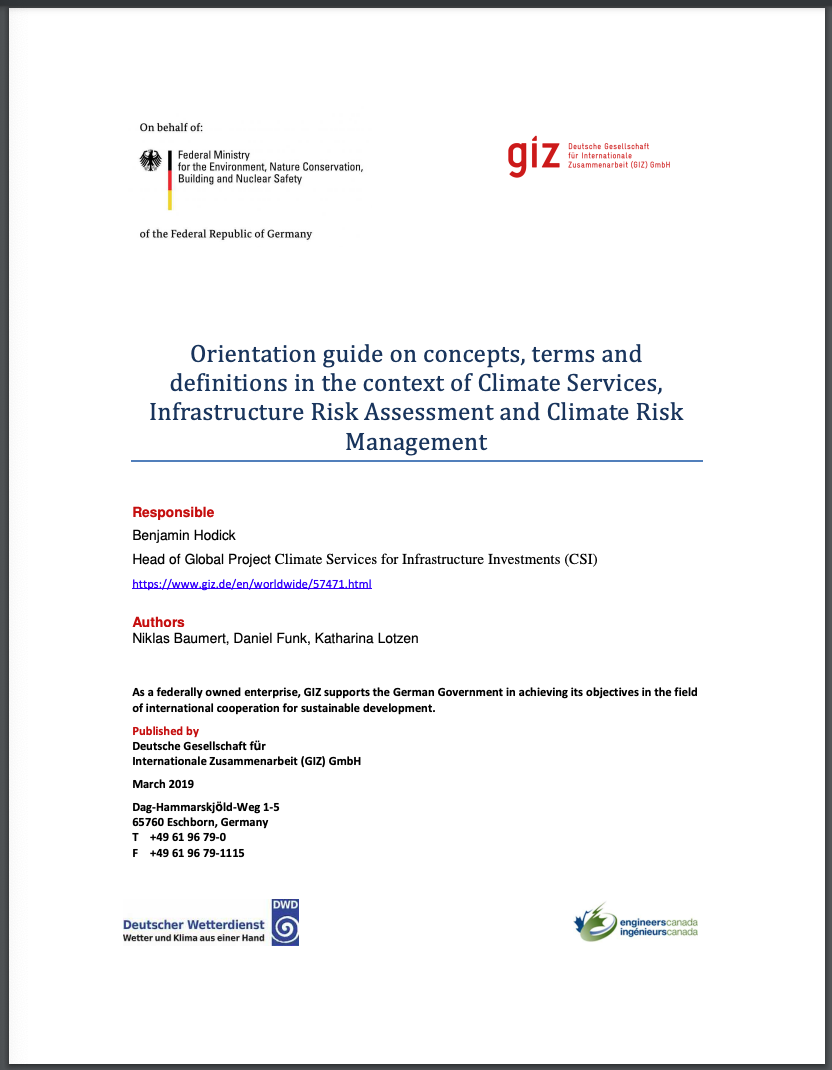Orientation Guide on Concepts, Terms and Definitions in the Context of Climate Services, Infrastructure Risk Assessment and Climate Risk Management

Introduction to Climate Concepts
This resource was submitted by the Climate Risk Institute fortheCanAdapt Climate Change Adaptation Community of Practice.
This article is an abridged version of the original text, which can be downloaded from the right-hand column. Please access the original text for more detail, research purposes, full references, or to quote text
This guide explores the common concepts, terms, and definitions used in Infrastructure Risk Assessments and Climate Risk Management. Below is a list of the clustered terms for which definitions are provided.
- Climate
- Climate services
- Climate data, climate parameters and their characterization
- Climate Modelling, Simulations and Projections
- System of Interest characterization (Infrastructure)
- Impact & risk
- Components of risk & risk causality
- Risk Assessment
- Infrastructure risk assessment
- Adaptation and Climate Risk Management
- Climate risk management options and assessment
Example definitions
Weather
The state of the atmosphere at a given time and place, with respect to variables such as temperature, moisture, wind velocity and barometric pressure (WMO 2011). In the context of the PIEVC Protocol: Weather refers, generally, to day-to-day temperature and precipitation activity. Climate refers to average atmospheric conditions over longer periods of time. A weather event are specific atmospheric conditions related to temperature, moisture, wind velocity, and barometric pressure. Within the context of the risk assessment, a weather event is defined by a value for specific atmospheric conditions that could potentially exceed infrastructure threshold values. A weather forecast is a prediction of individual weather elements on an hourly or daily basis. Forecasts are determined from a combination of weather model output, constrained by observed data every 12 hours, and local sources of information such as tracks of storms and precipitation from satellite and radar reports (Engineers Canada 2015).
Climate
Climate in a narrow sense is usually defined as the average weather, or more rigorously, as the statistical description in terms of the mean and variability of relevant quantities over a period ranging from months to thousands or millions of years. The classical period for averaging these variables is 30 years, as defined by the World Meteorological Organization. The relevant quantities are most often-surface variables such as temperature, precipitation and wind. Climate in a wider sense is the state, including a statistical description, of the climate system (IPCC_WG1 2013). The statistical character of climate has significant consequences on climate information and its usability. The interpretation of climate data (statistics) is very much dependent on the choice of the temporal and spatial scale as well as on the object (variable, indices) of analysis. In the context of Climate Services, temporal and spatial scales as well as the object of analysis for CS-products should be chosen with care and in the context of decision-making. A discussion about the usability of standardized climatological products and the need of specialized products should take place.
Related resources
- Exploring transdisciplinary approaches to support resilience and adaptation decision making
- Communicating climate change: A practitioner’s guide
- Communicating climate change adaptation: A practical guide to values based communication
- A Guide to the Science of Climate Change Communication
- Learning from failures in communication: sharing lessons from research & practice workshop
- Communicating climate change attribution: A toolkit for raising risk awareness
- The PLACARD taxonomies for CCA & DRR
- Adaptation – just a fancy new name?
- Vulnerability definitions
(0) Comments
There is no content